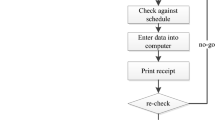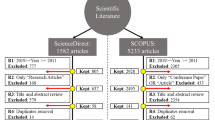Abstract
In a smart factory, setting a production plan, relocating production equipment, and producing small batches of various products in real-time at a low cost is essential. This study discusses clustering customer orders with the same or similar process routes using a sequential pattern-mining technique, simplifying the overall production process and reducing the relocation and restructuring of equipment and machines in smart factories. We present a similarity measure to evaluate the similarity between two process routes and mathematically formulate integer programming to solve the problem of clustering similar routes. Considering process routes with alternatives, we use sequential pattern-mining techniques to cluster customer orders and determine alternative routes related to customer orders.
We propose two sequential pattern-mining algorithms to expedite customer orders in smart factories. Algorithm 1 cluster customer orders and finds frequent process route patterns based on the similarity of the process routes. Algorithm 2 determines frequent sequential patterns based on the frequency of customer orders. We compared the results of 0–1 integer programming and Algorithm 1 and evaluated the algorithms' running time and memory space. This study demonstrates how data-mining techniques can be integrated into manufacturing systems to simplify process routes and reduce the complexity of the manufacturing process in the customer order phase.









Similar content being viewed by others
Availability of data and materials
Datasets analyzed during the current study are available in the https://figshare.com/account/articles/21657008.
References
Lozano S, Guerrero F, Eguia I, Onieva L (1999) Cell design and loading in the presence of alternative routing. Int J Prod Res 37(14):3289–3304
Van, HTH, Chau VN, Phung NH (2007) An expanded prefix tree-based mining algorithm for sequential pattern maintenance with deletions. In: Proceedings of 2nd International conferences on Information Technology, Information Systems and Electrical Eng (ICITISEE). pp 11–16
Jääskinen V, Parkkinen V, Cheng L, Corander J (2014) Bayesian clustering of DNA sequences using Markov chains and a stochastic partition model. Stat. Appl. Genet. Mol. Biol. 13(1):105–121. https://doi.org/10.1515/sagmb-2013-0031
Lam HT, M¨orchen F, Fradkin D, Calders T, (2014) Mining compressing sequential patterns. Stat. Analy. Data Mining 7(1):34–52. https://doi.org/10.1002/sam.11192
Soruri M, Sadri J, Zahiri SH (2018) Gene clustering with hidden Markov model optimized by PSO algorithm. Pattern Anal Applic 21:1121–1126. https://doi.org/10.1007/s10044-018-0680-9
Jamshed A, Mallick B, Kumar P (2020) Deep learning-based sequential pattern mining for progressive database. Soft Comput 24:17233–17246. https://doi.org/10.1007/s00500-020-05015-2
Fidalcastro A, Baburaj E (2017) Sequential pattern mining for intrusion detection system with feature selection on big data. KSII Trans Internet Inf Syst 11(10):5023–5038. https://doi.org/10.3837/tiis.2017.10.018
Rezig S, Achour Z, Rezg N (2018) Using data mining methods for predicting sequential maintenance activities. Appl. Sci 8(11):2184
He Z, Zhang S, Wu J (2019) Significance-based discriminative sequential pattern mining. Expert Systems with Applications. 15(122): 54–64. http://archive.ics.uci.edu/ml/datasets/Online?Retail#
Djenouri Y, Belhadi A, Lin JCW, Cano A (2019) Adapted k-nearest neighbors for detecting anomalies on spatio–temporal traffic flow. IEEE Access 7:10015–11002
Dam TL, Ramampiaro H, Nørva˚g K, Duong QH, (2019) Towards efficiently mining closed high utility itemsets from incremental databases. Knowl-Based Syst 165:13–29
Lin JC, Li T, Pirouz M, Zhang J, Fournier-Viger P (2019) High average-utility sequential pattern mining based on uncertain databases. Knowl Inf Syst 62:1199–1228. https://doi.org/10.1007/s10115-019-01385-8
Belhadi A, Djenouri Y, Lin JC, Zhang C, Cano A (2020) Exploring pattern mining algorithms for hashtag retrieval problem. IEEE Access 8:10569–10583
Huynh HM, Nguyen LTT, Nguyen VB, Tseng AVS (2020) Efficient methods for mining weighted clickstream patterns. Expert Syst Appl 142:112993
Jamshed A, Mallick B, Kumar P (2020) Deep learning-based sequential pattern mining for progressive database. Soft Computing. 24:17233–17246
Lee GH, Han HS (2020) Clustering of tourist routes for individual tourists using sequential pattern mining. J Supercomputing 76(7):5364–5381. https://doi.org/10.1007/s11227-019-03010-5
Pinaire J, Chabert E, Azé J, Bringay S, Landais P (2021) Sequential pattern mining to predict medical in-hospital mortality from administrative data: application to acute coronary syndrome.". J Healthcare Eng 2021:5531807. https://doi.org/10.1155/2021/5531807
Li Y, Zhang S, Guo L, Liu J, Wu Y, Wu X (2022) NetNMSP: nonoverlapping maximal sequential pattern mining. Appl Intell 52(9):861–9884
Yang G (2006) Computational aspects of mining maximal frequent patterns. Theoret Comput Sci 362(1–3):63–85
Leue S, Befrouei MT (2012) Counterexample explanation by anomaly detection. Lect Notes Comput Sci. 7385:24–42
Strozzi F, Colicchia C, Creazza A, Noè C (2017) Literature review on the ‘Smart Factory’ concept using bibliometric tools. Int J Prod Res. 55(22):6572–6591. https://doi.org/10.1080/00207543.2017.1326643
Kusiak A (2018) Smart manufacturing. Int J Prod Res 56(1–2):508–517. https://doi.org/10.1080/00207543.2017.1351644
Funding
Partial financial support was received from Soongsil University to prepare this manuscript.
Author information
Authors and Affiliations
Contributions
This study is supported by Soongsil University.
Corresponding author
Ethics declarations
Conflict of interest
The author declares that they have no known competing financial interests or personal relationships that could have appeared to influence the work reported in this paper.
Additional information
Publisher's Note
Springer Nature remains neutral with regard to jurisdictional claims in published maps and institutional affiliations.
Rights and permissions
Springer Nature or its licensor (e.g. a society or other partner) holds exclusive rights to this article under a publishing agreement with the author(s) or other rightsholder(s); author self-archiving of the accepted manuscript version of this article is solely governed by the terms of such publishing agreement and applicable law.
About this article
Cite this article
Lee, G.H. Clustering customer orders in a smart factory using sequential pattern mining. J Supercomput 79, 18970–18992 (2023). https://doi.org/10.1007/s11227-023-05351-8
Accepted:
Published:
Issue Date:
DOI: https://doi.org/10.1007/s11227-023-05351-8




